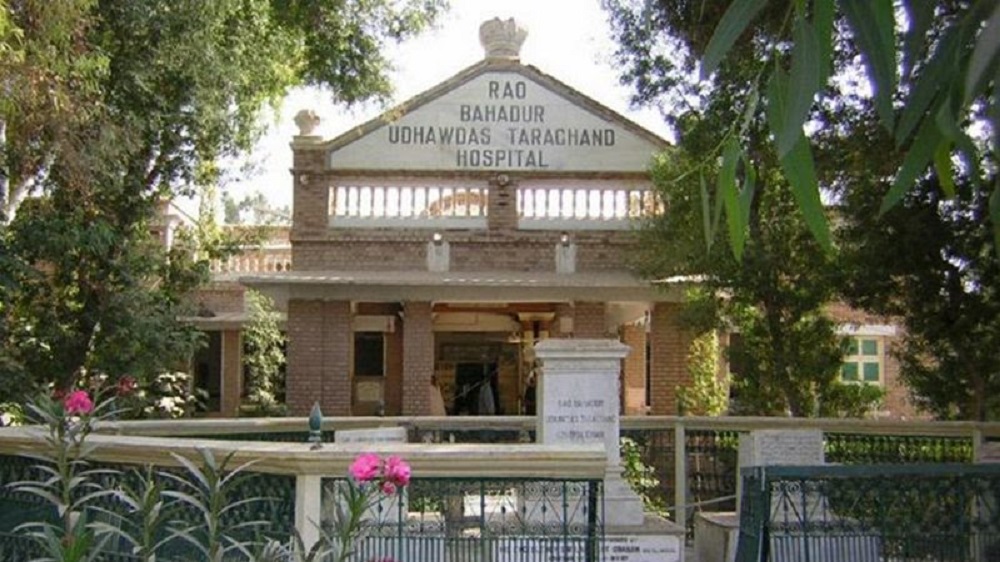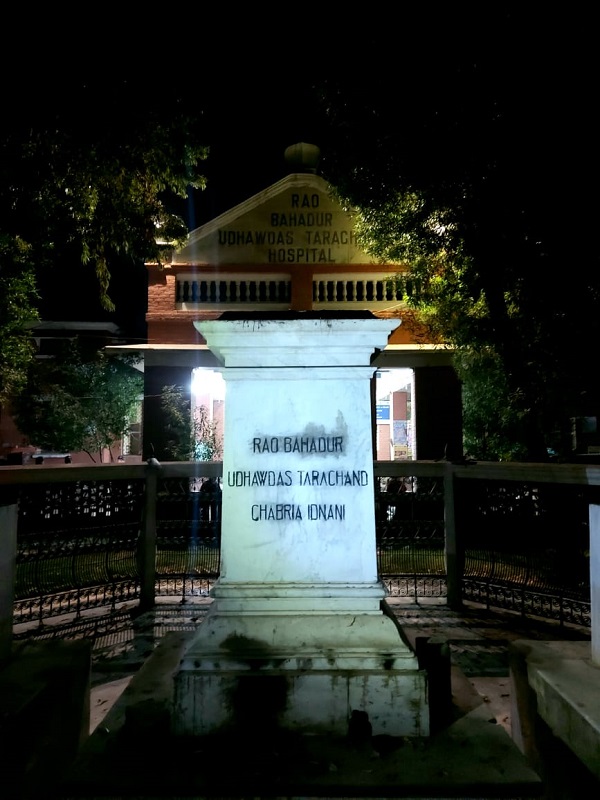
Udhaw Das’ family moved to India after Partition, but his descendants continue to visit Shikarpur and donate to the hospital. However, the statue of Udhaw Das Tarachand is long gone from the place.
By Muhammad Asif Nawaz
Anyone with even a passing interest in Urdu literature would be familiar with the works of the oft-celebrated writer Saadat Hassan Manto. Manto was frequently summoned to court for his poignant stories that highlight the irony and starkness of reality, particularly during the time of Partition. One of Manto’s stories called “Juta” (known as “The Garland” in English), narrates the true incident of a mob attacking the statue of Sir Ganga Ram in Lahore. In the wake of the riots that came with Partition, a group of people surrounded the statue of the great Hindu philanthropist, adamant to bring it down. When one member of the mob ascended the statue to put around its neck a garland of shoes, he was shot at by the police. Injured, he had to be taken to a hospital. And the irony of the story is underlined by the choice of the hospital: the man was taken to Ganga Ram Hospital; built by the same person whose memory he had resolved to erase from Lahore’s Mall Road.

Today, across the length of the country, such stories can be heard, some more widely recorded than others. The exercise to divide the combined history and heritage of Pakistan and India led to many wayward incidents. Another glaring example of the tradition can be found some 800 kilometers south of where Manto’s story is based, in the Sindhi city of Shikarpur. In the bustling center of the city, which once was a prosperous area, stands the century-old Civil Hospital of Shikarpur, also known as RBUT Hospital named after the person who built it: Rai Bahadur Udhaw Das Tarachand.

Pedestal from where the statue of Rai Bahadur Udhaw Das was removed
It was around the year 1980 that the Rai Bahadur Udhaw Das Tarachand’s statue was finally razed to the ground. This was a result of communal violence when a religious party took upon itself to reinterpret and ‘Islamize’ our history. The statue was then shifted to Sindh University in Jamshoro, where it remains to this date.
 Born in Shikarpur in 1870, Udhaw Das was a sugar trader who eventually became one of the best-known philanthropists in the area. After his mother died due to a lack of medical facilities in the city that only had a lone dispensary, which was established in 1857. Das took it upon himself to provide a good hospital for this city. By the start of the 20th century, the Shikapur Municipal Committee was also trying to establish a hospital in the city. Das partnered with them and soon took over the process. His contribution to the hospital was a hefty sum of Rs.100000, the result of his persevering efforts to get people to donate to the cause. The names of all the donors, largely Hindus, along with their sums of donations, are still inscribed on the walls of the hospital as you enter. The construction of the hospital started in 1933 and was inaugurated by Sir Lancelot in 1937, who was the governor of Sindh. It became the best medical facility in the city. The hospital provided free access to the public. Even after its inauguration, Udhaw Das kept on working for the hospital, and it was in Bombay, where he had gone for donations, that he fell severely ill and died. After his death, not only was the hospital named after him, but his statue was also erected at the entrance. The administrative control of the hospital went to Udhaw Das’ son.
Born in Shikarpur in 1870, Udhaw Das was a sugar trader who eventually became one of the best-known philanthropists in the area. After his mother died due to a lack of medical facilities in the city that only had a lone dispensary, which was established in 1857. Das took it upon himself to provide a good hospital for this city. By the start of the 20th century, the Shikapur Municipal Committee was also trying to establish a hospital in the city. Das partnered with them and soon took over the process. His contribution to the hospital was a hefty sum of Rs.100000, the result of his persevering efforts to get people to donate to the cause. The names of all the donors, largely Hindus, along with their sums of donations, are still inscribed on the walls of the hospital as you enter. The construction of the hospital started in 1933 and was inaugurated by Sir Lancelot in 1937, who was the governor of Sindh. It became the best medical facility in the city. The hospital provided free access to the public. Even after its inauguration, Udhaw Das kept on working for the hospital, and it was in Bombay, where he had gone for donations, that he fell severely ill and died. After his death, not only was the hospital named after him, but his statue was also erected at the entrance. The administrative control of the hospital went to Udhaw Das’ son.


His name is written on the floor at the entrance to the hospital, and anyone seeking medical treatment treads on it.
Today, the hospital is a quaint, impressive sight, notwithstanding the desperation of patients and the overall gloomy state it has fallen into. It retains much of its past architectural glory, from the floors to the ceilings, and the memories of the people who saw this turn into a reality can all be amply felt in the place. Udhaw Das’ family moved to India after Partition, but his descendants continue to visit Shikarpur and donate to the hospital. However, the statue of Udhaw Das Tarachand is long gone from the place.

In front of the hospital, while the empty pedestal is still there, unfortunately, it wasn’t only once that the statue of Udhaw Das was defiled. Attacks were mounted at the statue during the Partition era as well, but they caused minor damage to it, and it was many decades later that the statue was finally removed from the site. While the hospital staff told us that it happened in the wake of riots that happened after the Babri Masjid demolition in India, our research revealed that it was around the year 1980 that the statue was finally razed to the ground. This was a result of communal violence when a religious party took upon itself to reinterpret and ‘Islamize’ our history. The statue was then shifted to Sindh University in Jamshoro, where it remains to this date.

The plaque on the inauguration of the hospital
But while some intolerant people have been able to remove the statue of the man from the premises, but his legacy lives on. The verses penned down in Sindhi by Udhaw Lal are still present on the walls of the hospital and define what the man stood for. A loose translation of some verses goes:
“The sick should be served with truth and love,
A human is the one who serves other humans.
If you want God to love you, cater to the poor,
If you want God to help you, help those in need.”

His death anniversary continues to be celebrated every year in recognition of his services to the city. His name is written on the floor at the entrance to the hospital, and anyone seeking medical treatment treads on it. Perhaps this is the greatest testament to the man, for he saw himself as silently serving them. And, by extension, even in the absence of a statue, Udhaw Das continues to breathe life into the hospital he dedicated his life to.
_____________________
Courtesy: Youlin Magazine (Posted on: December 21, 2022)